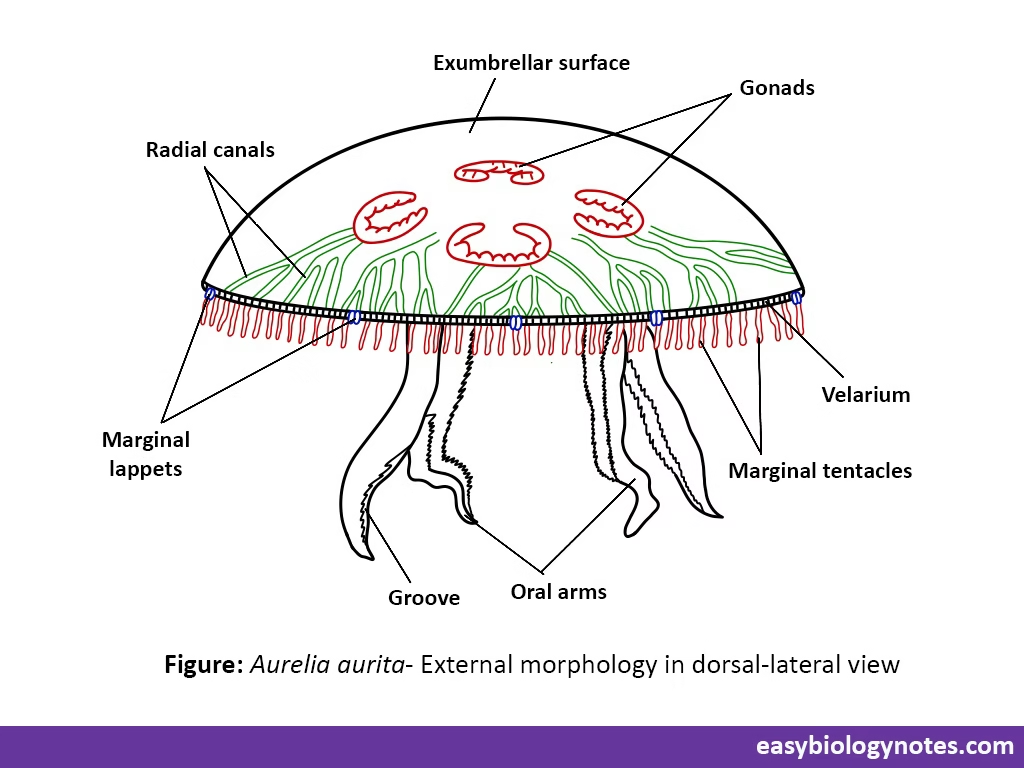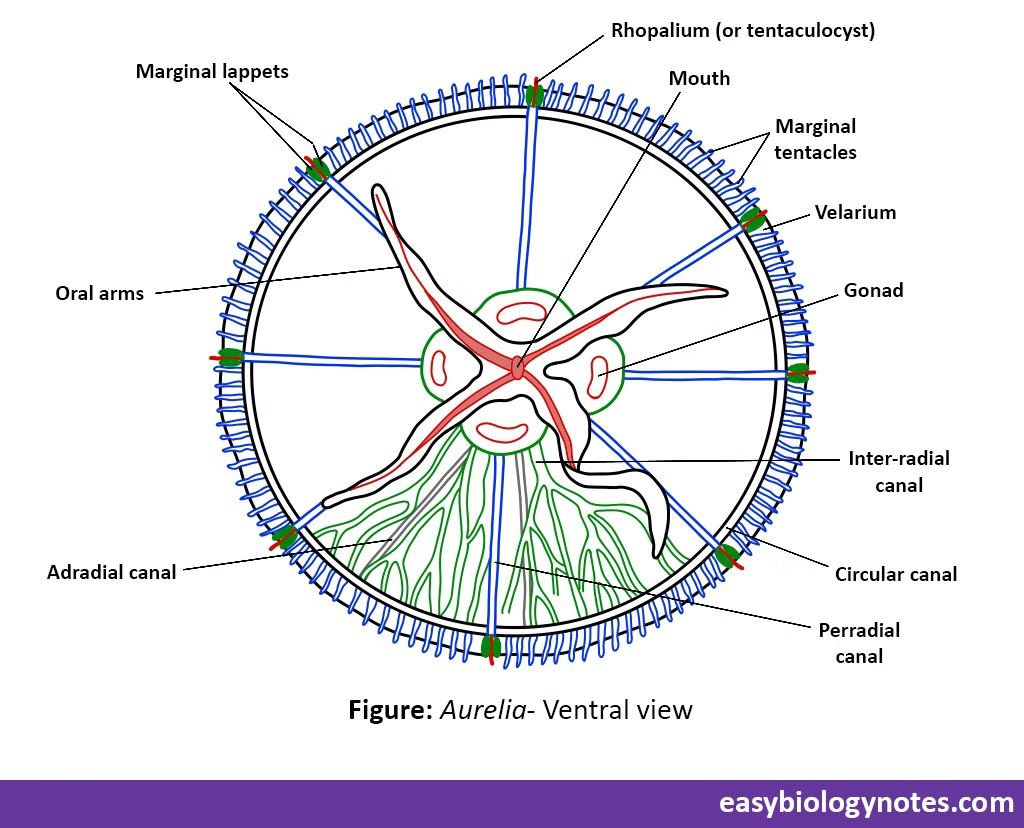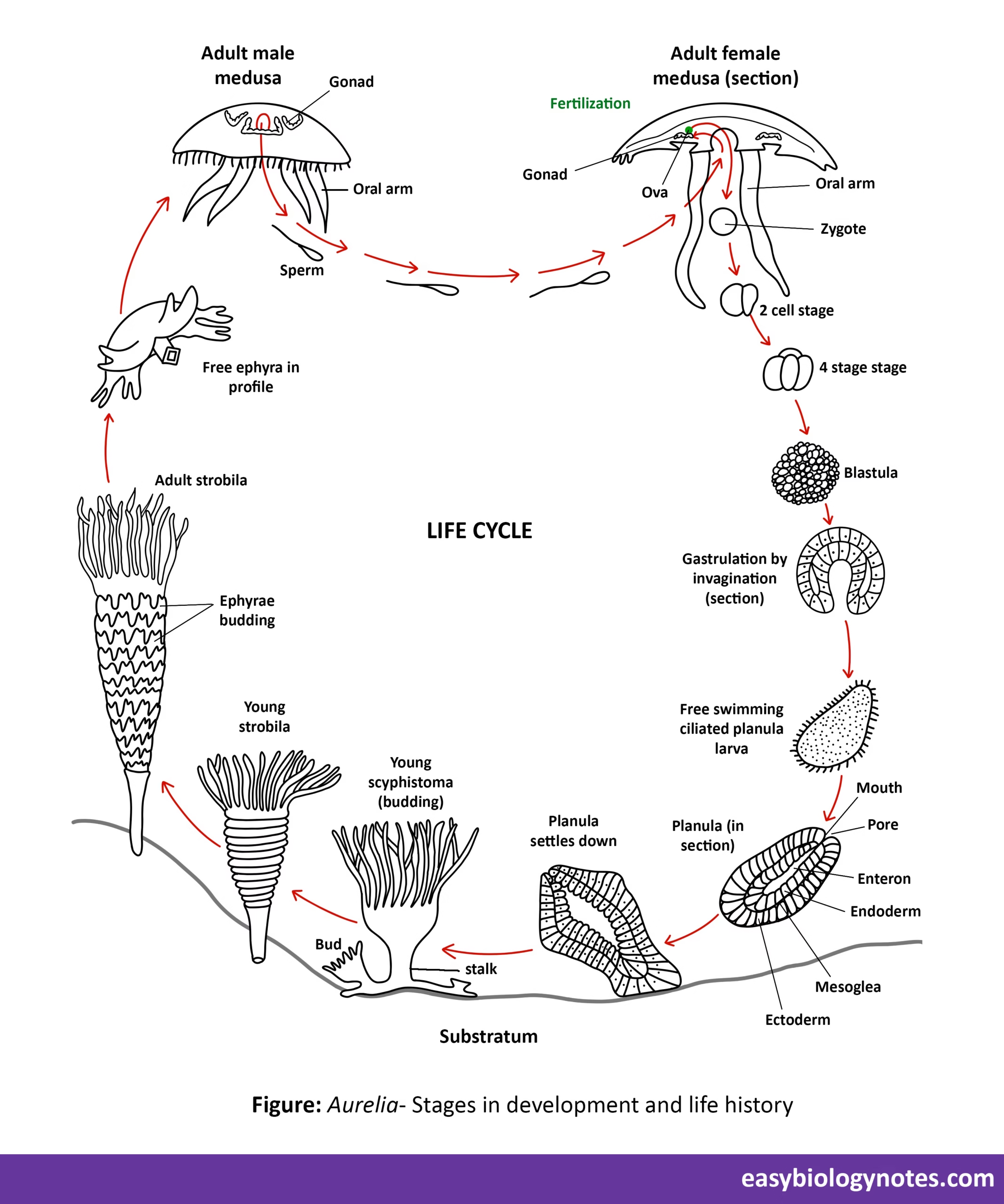Aurelia aurita
- Jelly fishes are animals which belong to the class Scyphozoa of phylum Coelentrata. In this class (Scyphozoa), medusa is the dominant and conspicuous zooid in the life cycle while polypoid form is restricted to a short larval stage.
Systematic position of Aurelia aurita
Phylum : Coelentrata
Class : Scyphozoa
Order : Semaeostomae
Family : Ulmaridae
Genus : Aurelia
Species : aurita
* Aurelia aurita is also popularly known as “moon-jelly”.
External morphology of Aurelia aurita
- It is easily recognised by its soft bell or umbrella-shaped body with four red or purple horseshoe-shaped gonads on its upper surface and four long and narrow oral lobes hanging downward from the lower surface.
- Its circular body measures about 90mm in diameter and presents a convex aboral or exumbrellar surface and a concave oral or subumbrellar surface.

- From the centre of subumbrellar surface hangs down a very short and inconspicuous manubrium.
At its free distal end is a square mouth, from each corner of which hangs down a long tapering, much-frilled and delicate process, the oral arm. - Each of the four oral arms has a ventral ciliated groove leading into mouth and its edges are armed with nematocysts.
- The margin of the umbrella is divided into eight lobes or lappets by notches.
- Each notch contains a tentaculocyst or rhopalium enclosed by a pair of marginal lappets.
- Numerous short, hollow tentacles are present all round along the margin of the umbrella and are known as marginal tentacles.
- On the subumbrellar surface lying between the oral arms are four rounded apertures leading into shallow pouches called subgenital pits.

Life cycle and reproduction of Aurelia
Aurelia is dioecious,i.e., the male and female sexes are separate but there is no sexual dimorphism.
1) Sex organs
- Testes and ovaries are similar in appearance. A medusa has 4 horseshoe-shaped gonads lying on the floor of stomach periphery,i.e., one in each gastric pouch.
- On maturity, ova and sperms break into the gastrovascular cavity and pass out of the mouth with the outgoing water current. The ova or eggs are lodged in the frills of oral arms.
2) Fertilization
- Spermatozoa, swimming about in water, reach the ova and fertilize them either in stomach of female or in the frills of oral arms. Thus, fertilization is either external or internal.
3) Formation of planula larva
- Frills of oral arms serve as temporary brooding members. Here each fertilized egg or zygote undergoes early development into a ciliated larval stage called planula.
- The zygote undergoes holoblastic and equal segmentation to produce a solid ball-like morula. Soon it is transformed into a single-layered blastula, enclosing a central fluid-filled cavity or blastocoel.
Two layered gastrula then develops by invagination, with its blastopore or gastral mouth not completely closed. - The embryo now elongates, its outer cell become ciliated, blastopore closes and the typical planula larva is formed.

4) Formation of Scyphistoma
- The ciliated planula eventually escapes the frills of oral arms and after a short free-swimming existence, attaches itself to a substratum by its broad anterior, aboral end.
- Cilia are lost and a mouth opens at its free distal end where blastopore had closed.
- The larva now becomes elongated and metamorphosed into a trumpet-shaped polyp.
- Tentacles bud around the mouth. First 4 tentacles are perradial, subsequent 4 interradial and then 8 adradial in position. Thus, 16 long and slender tentacles are formed.
- Mouth becomes square in outline and its edges become elongated to form short manubrium.
- Scyphistoma feeds and grows up to 12mm in height and may survive in this stage for several months.
5) Formation of ephyrae (Strobilation)
- In autumn and winter, scyphistoma undergoes a remarkable process of budding or transverse fission of oral end, called strobilation.
- Distally, body develops a series of ring-like transverse constrictions or furrows which gradually deepens, so that the organism resembles a pile of minute saucers or disc placed one above other.
- At this stage, scyphistoma with a segmented body is called strobila and each of the segments is called an ephyra larva.
- The ephyra are connected by muscular strands. As they get older, they are pinched off from the parent strobila, which turn over, and swim away as little medusae or jelly-fish.
* When the food is plentiful, several ephyrae are produced at a time and when there is scarcity of food only a single ephyra is produced.
- As growth proceeds, ephyra is finally transformed into adult Aurelia. An ephyra formed in winter becomes a sexually reproducing adult medusa by spring or summer.